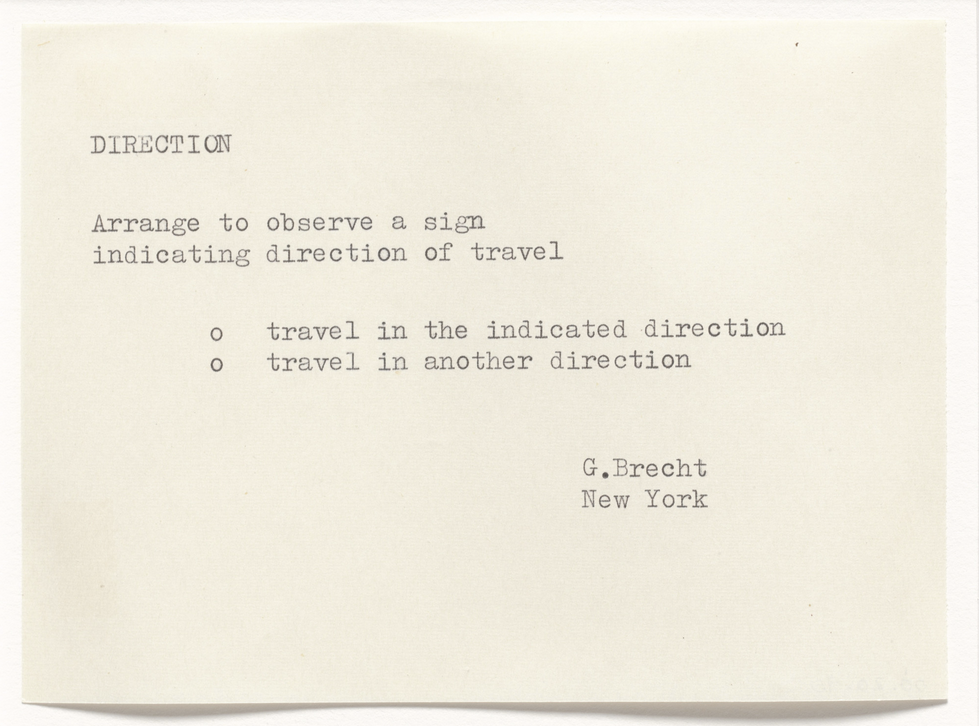
George Brecht, Direction (1962) – credit

George Brecht, Direction (1962) – credit
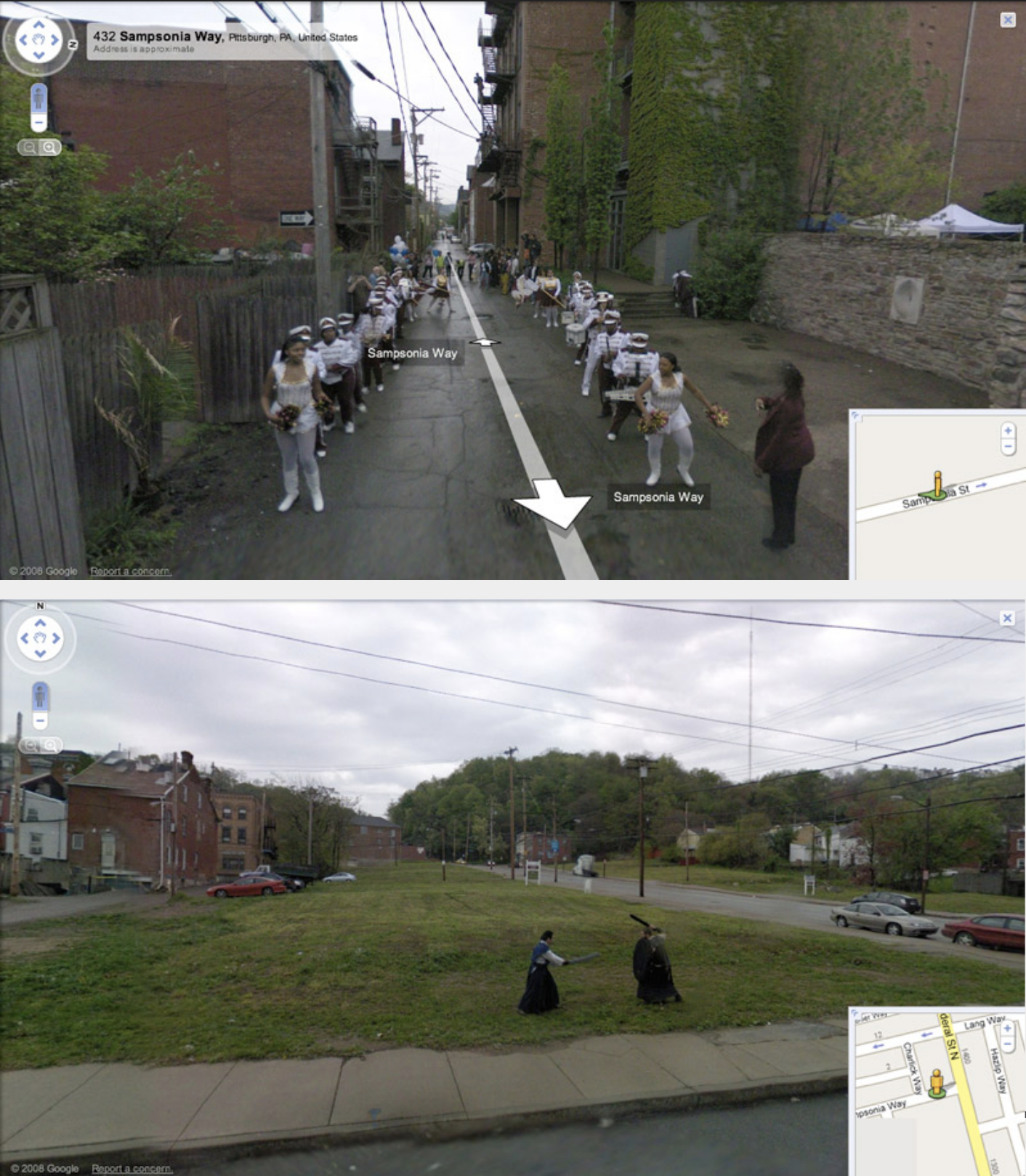
Hewlett and Kinsley invited the Google Inc. Street View team and residents of Pittsburgh’s Northside to collaborate on a series of tableaux along Sampsonia Way.
Technicians captured 360-degree photographs of the scenes in action and integrated the images into Street View.
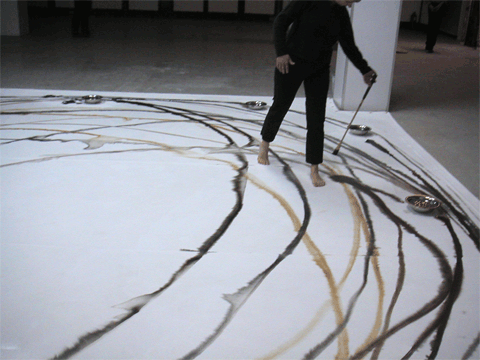
“Duration’s Wisdom II was made on the floor, by using a long handmade paintbrush. Twelve silver bowls were filled consecutively with black ink, brown pigment and water placed in a circle around the canvas. Dipping the brush into the bowls, placing it on the canvas and walking around the painting, she created a long circular, continuous line. Redipping the brush whenever needed, “I simply walked as long as I could around and around the canvas until I could walk no longer.” [credit]
This work has multiple sections: déambulation, where the artist silently walks across the screen carrying two bags wearing a white dress; Expansion, where the artist walks up stairs and across the screen – the image is doubled and reflected with reduced opacity and there is piano music playing; Transcription, where the artist walks across the screen in a white dress with a piece of chalk drawing a hip-height line across a black wall, then erases the lines with water – again the image is doubled during the drawing, but not the erasing, and music is present for the erasure.
“My work exists within an intermediary zone, a sort of matter space of a frontier I have produced and that I situate within the countries of France and the Democratic Republic of Congo. I am a cultural hybrid endowed with a composite identity. The plurality of my parents provide me with the authorization to interrogate my own history and that of a nation, the place of my birth, as well as the continent of Africa at large. The relationship that I maintain with my own personal history or histories and to history as a larger entity permits me to formulate a critical acquisition to write the concept of exitism. Exitism is a representation that is largely shared with history and even with practices at times. As the material of my work is always simple. I use historical facts that I interpret through the prediction of scene. Through these frontal images I expose my body that I use as a metaphor for the relationship between the human being and the world at large. My work sets up a direct relationship that centered on the world the field of society and politics. – Excerpts from Global Feminisms: Michèle Magema 2010″ [credit]
Oyé Oyé / screen 2 from Michèle Magema on Vimeo.
Oye Oye, 2002
Video, 5:30 min.
Michèle Magema
* 1977 Kinshasa, Democratic Republic of Congo
“In Oyé Oyé Michèle Magema deals with the Memory of the father and an entire generation of men and women who were eager to achieve a modern Africa. Oyé Oyé is about nation-building, a stop on the journey to a so-called « utopialand ». It is the raving story of a man who seized power and perverted history, Mobutu Sese Seko, who ruled Zaire (now Democratic Republic of Congo) from 1965 to 1997. Mobutu pursued a phantasmagorical vision of an « authentic » Africa. (« Autenticity » was political, social, economic, and cultural ideology implemented in 1970 with the goal of shaking off all colonial influence, to the point of banning Western poducts and prohibiting Christian names.)
Magema’s Oyé Oyé is a two-channel video installation; on one side the artist, shown without a head, mimes a military march; on the other are public images from the Mobutu era, such as parades. In both the African female body is shown as an instrument of propaganda. By parodying the political concept of identity, Magema forces us to reconsider a country’s past.
This work utilizes equal spacing between each walker – a concept Fulton explored in “Walk dance art co” created by Christine Quoiraud & Hamish Fulton, at Chamarande in 2002 (with 23 other artists).
“At the corner of Bogie Street and Church Street, we get our instructions for today’s choreographed walk. For the next two hours, about 30 of us will walk repeatedly around the same block. We will walk in single file, maintaining a two-metre distance from the person in front. We will not talk.
So the focus of my attention for the next two hours are the heels of Allan Watson, course leader in sculpture at Gray’s School of Art. He’s taller than me, and there are moments when I have to jog to keep two metres between us. Passers-by stop to stare or snigger at this kenspeckle procession. By the fifth circuit, my calf muscles are screaming.
But by the tenth, something strange has happened. My legs don’t hurt anymore. My mind has relaxed. Time feels as if it is liquefying. Has it been ten laps, or 50? It doesn’t matter. I have no demands on my time, nothing is required of me but simply to walk. I wonder, briefly, if this is what it’s like to be Hamish Fulton.
Fulton is the artist who walks. For 40 years, he has made works of art exclusively relating to his walks. He has walked for thousands of miles in five continents. He has walked without sleep, got frostbite, climbed to 8,000m (26,246ft) without oxygen. He has got lost, been caught in storms, fallen down a crevasse (his rucksack wedged, allowing him to climb back out).
More recently, he has begun to choreograph walks involving groups of people, the idea of repetition inspired by the “Marathon Monks” of Mount Hiei in Japan, whose spiritual discipline involves running 40km (25 miles) a day on a repetitive circuit of the mountain. Focusing on the feet ahead of you becomes a secular meditation, a stilling of the mind. “It is a vehicle for a change of mind, a shift in where the mind’s located,” he says, carefully. “I think our minds go round and round and round in the same furrows, and possibly, when you do a walk like this, you go to another part of your mind. It sets in motion a variety of perceptions.
Fulton is in Huntly at the invitation of Deveron Arts, which invites world-class artists to run socially engaged projects in the town. The next day, some of the same walkers joined him on the first day of a 21-day walk in the Cairngorms. Over half a pint of lager in the Huntly Hotel, Fulton reflects that, of all the obstacles he has had to overcome in a lifetime of walking, he has never before been marooned by a cloud of volcanic ash (he eventually arrived by train after his flight to Scotland was cancelled). “It’s incredible, isn’t it? I know it’s costing so much loss of income for lots of people, so I’m sorry for that, but there is something… inspiring about it.
“We see the world in terms of us being able to build everything and make everything. But there are these other things, like volcanos, that we didn’t build. In these times, it’s pretty strange there is this other force, because we’re so used to pushing buttons and Googling data about something.”
Fulton was a contemporary of Richard Long and Gilbert & George at Central St Martins College of Art in the 1960s. He grew up in Newcastle, and his formative experiences of walking were on family holidays to Arran. He was profoundly influenced by a visit to the United States in 1969, when he walked at the site of the Battle of Little Bighorn in Montana and read the work of Native American Luther Standing Bear, who wrote in the 1930s about the Sioux relationship with the Earth. In terms of art, it was an era of exploding potential: art happened outside museums; art was experience; art could be a walk.
The ideas which crystallised at that time have remained consistently central to Fulton’s work. Unlike Richard Long or an artist such as Andy Goldsworthy, he makes no work in the landscape and takes nothing away. The work he makes afterwards – often using photography and graphic text – reflects the walk but cannot reproduce it. The walk and the work are separate creative acts. His work is evocative, but minimalist; Japanese haiku poetry is a key influence. A walk in Wyoming’s Wind River range became just two words: CLOUDS STONES. A road walk across Spain and Portugal is WARM DEAD BIRD. Seven days in the Pyrenees is simply RAIN.
By the time you read this, Fulton will have been in the Cairngorms for four days, carrying his tent, food and fuel. He has no plan, other than to arrive at Glenmore Lodge exactly 21 days after he set out. He will not film or webcast his trip. What happens in the mountains is a mystery, though prosaic details do slip out: one of the most important tools for a serial walker is his nail-clippers. Short toenails are essential for comfort.
“The Cairngorms are like a person, I’m very fond of them. And, of course, anywhere like that is always threatened. So much of the world is either factory, agriculture, roads or housing, as time goes by these spaces are more and more unusual.
“I make the plan up as the days go by, which is extremely luxurious when everything in life has to be so controlled and planned. And then you have loss of control – someone sends you an e-mail, and you have to reply immediately, and then you realise that they sent their e-mail late. All this absurd behaviour that we just slip into.” Stepping into the unknown is a key component. “That’s the difference between making a geometric painting, where you’re fulfilling the plan, and something like this where you’re casting off, and you genuinely don’t know what the outcome can be. It could be a fall, or a wonderful sunrise; you don’t know.”
Fulton is not shy of being political. He is concerned about climate change, but speaks of the need for a profound shift in our relationship with the Earth, rather than simply incorporating a “green economy” into a money-driven system.
Last year, he organised a protest – a walk, of course – for Tibetan freedom, attended by Palden Gyatso, a Tibetan monk imprisoned by the Chinese for 33 years. A recent wall painting bears the words: “GOOGLE PALDEN GYATSO”. Those who do will find a story of torture and endurance. But in China, the link is blocked.
Last May, at the age of 62, Fulton reached the summit of Everest. An artist’s book about his journey will be published this summer. After a lifetime of walking, he was on top of the world.
“It is doing something which is unbelievable. We want a lot of things we want to be unbelievable but they’re not really. In this case, this completely fulfils the objective of doing something that feels unbelievable. The reality doesn’t hit you until five days later.” With that behind him, a forecast of snow in the Cairngorms is hardly a concern. The walking philosopher just shrugs, smiles and heads off into the unknown, one step at a time.” [credit]
A large number of people walked across the stage at different intervals. Each performance was an improvisation.

Norma Hunter, Walk this Way (2010) [credit]
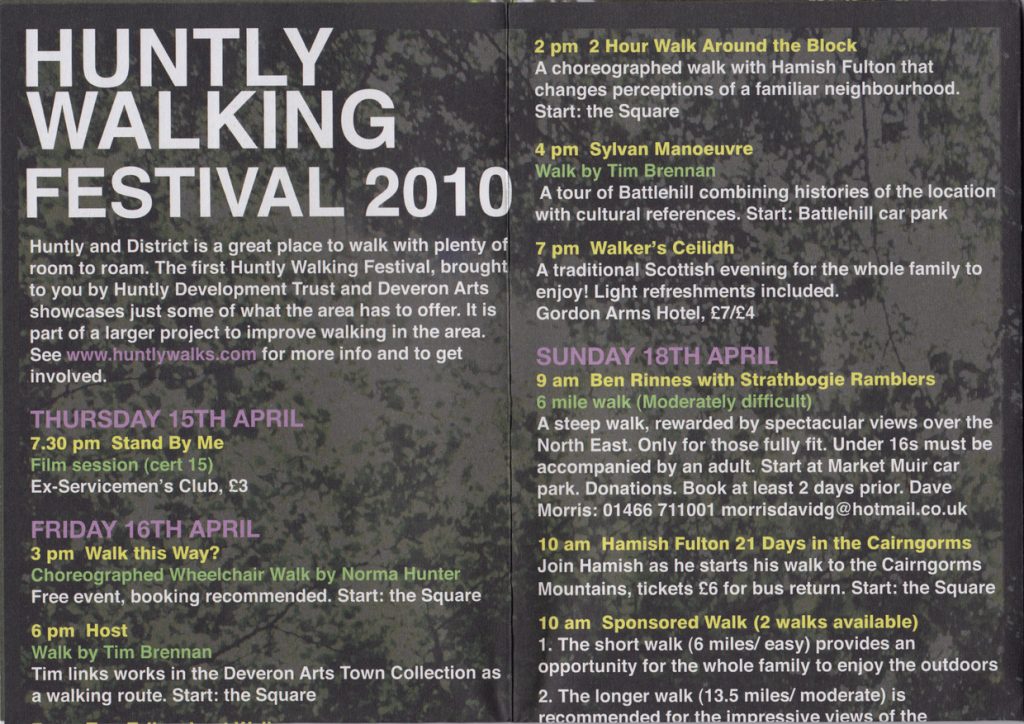
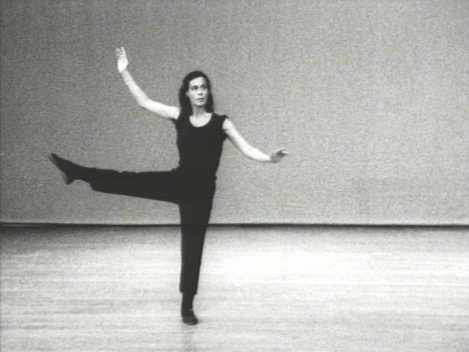
Yvonne Rainer, “Trio A” 1978. Video (black and white, sound), 10:21 min
“Yvonne Rainer—regarded as a foundational force in American contemporary art, film, and postmodern dance—began her career in New York in 1956. After a false start in acting, she entered the Martha Graham School, a dance school and associated company named for its founder, who is largely credited with revolutionizing modern dance. There, Rainer discovered a passion for this art form. She was trained in a style of movement characterized by expressiveness and virtuosity and in narrative choreography filled with drama and psychological intensity. But Rainer grew dissatisfied with the conventions of modern dance and the traditional relationship between dancer and audience. As she has explained: “Early on, I began to question the pleasure I took in being looked at, this dual voyeuristic, exhibitionistic relation of dancer to audience.”1 Fueled by such questioning, and her opposition to the tenets of classical and modern dance, she created Trio A.
Rainer choreographed Trio A in 1966, and performed it for the camera in 1978. Written for a solo performer, it incorporates no music and features a seamless flow of everyday movements like toe tapping, walking, and kneeling. “[It] would be about a kind of pacing where a pose is never struck,” the artist once described. “There would be no dramatic changes, like leaps. There was a kind of folky step that had a rhythm to it, and I worked a long time to get the syncopation out of it.”2 Trio A positioned Rainer as a leader among the dancers, composers, and visual artists who were involved in the Judson Dance Theater (which she co-founded in 1962), an avant-garde collaborative that ushered in an era of contemporary dance through stripped-down choreography and casual and spontaneous performances.
Yvonne Rainer’s “No Manifesto”
A year before creating Trio A, Yvonne Rainer wrote her “No Manifesto” (1965). Through it, she declared her opposition to the dominant forms of dance of the period—typified by Martha Graham—and outlined the tenets of her radical new approach:
No to spectacle.
No to virtuosity.
No to transformations and magic and make-believe.
No to the glamour and transcendency of the star image.
No to the heroic.
No to the anti-heroic.
No to trash imagery.
No to involvement of performer or spectator.
No to style.
No to camp.
No to seduction of spectator by the wiles of the performer.
No to eccentricity.
No to moving or being moved.3
Early Recognition—a Double-Edged Sword?
Sometimes, artists find that groundbreaking work produced early in their career may overshadow the rest of their output. This was the case for Rainer with Trio A and “No Manifesto.” In her words: “It’s a little unfortunate, because it eclipses everything else I’ve done. [It’s] the most out-there, visible signature of my career. That and the ‘No Manifesto.’”4 In the 1970s, she stopped dancing altogether and turned her attention fully to filmmaking, producing films including Lives of Performers (1972), Kristina Talking Pictures (1976), and Privilege (1990). It was not until the 2000s that Rainer would return to choreography.” [credit]
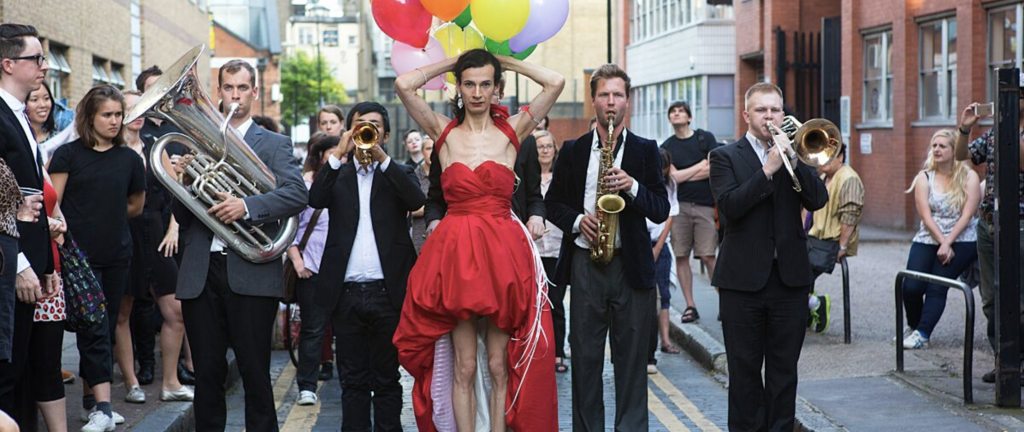
Nando Messias, The Sissy’s Progress (2014)
“by Nando Messias
Musical director Jordan Hunt
Nando Messias was beaten up on the street in an act of homophobic hatred. After years of dreaming up his response, he presents The Sissy’s Progress, a spectacle of provocation, celebration and hyperflamboyance.
Part dance-theatre, part walking performance, The Sissy’s Progress leads its audience out onto the streets with a live marching band playing original music composed by Jordan Hunt. The Sissy’s Progress confronts the harsh contradictions of gender and violence of city life, standing up for sissies everywhere. ”